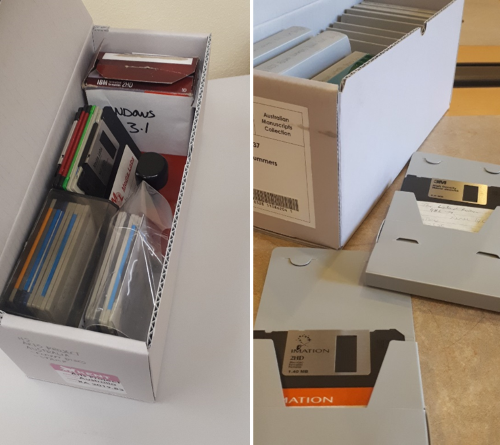Kevin Molloy is Manuscripts Collection Manger at State Library Victoria in Melbourne, Australia
Floppy disks have a remarkable technological provenance that dates from the late 1960s. Developing through many iterations, the standard 3½ inch disk, produced from 1981, had become largely ubiquitous by the 1990s as the go-to format for business, personal storage and transfer systems. Use of the 3½ floppy lasted until the mid-2000s, and, as a storage device, is found in many physical collections of unpublished papers acquired by State Library Victoria’s Manuscripts Team. Examples from quite diverse collections, include the papers of writers Sonya Hartnett and Peter Carey, the business records of Coles Myer and Bryant and May, the papers of journalist Christopher Bantick, politician Joan Kirner, chefs such as Mietta O’Donnell, and collections like the Miss Australia Company Records.
The challenges of prioritizing the processing of digital formats (and their carriers) is generally the result of a number of historical factors, particularly in the pre-digital forensic world, where the ability to fully interrogate such formats with now readily available technologies like KryoFlux and similar systems, or to easily integrate carriers and their content into descriptive and access systems, have proved a barrier for the work of collecting institutions.

Fig 1 Incoming pre-processed obsolete digital carriers
Floppy disks are one of the most prevalent carriers found in collection offers to the State Library, and certainly the most overlooked format our institution houses. This is partly because of older archival presumptions concerning the nature of such formats i.e. that the data content was small and therefore not significant; that floppy disks were used only as ‘storage devices’ and therefore fell into the back-up category (similar to photocopies); that they housed nothing of major import that could not be found amongst the physical papers or collections in which they arrived; and finally, that the data would remain readable (stable) and accessible over time.
However, the life of magnetic disks are time-limited. Many carriers that have arrived at State Library Victoria are more than twenty years old and border on end-life usability. In a period when forensic technologies were not readily available and older descriptive practices privileged hard-copy description of manuscript paper-based formats, floppy disks have not been adequately examined or identified in catalogue and descriptive lists in any detail, despite the fact that they potentially contain significant unique material. Partly this is the result of identification. For example, floppy disks are often user-labelled with the most rudimentary of notes, or in many cases, minimalist ciphers - numbers, peoples’ names, or symbols, not terribly different to current unstructured user descriptive practices with born-digital files – and why stress about naming when the physical carrier can be identified by colored label or any other number of identification symbols! Such are some of the issues with these carriers.

Fig 2 Examples of user labelling
In short, the absence of robust workflows for undertaking disk imaging remains an on-going challenge, something identified by the National and State Library of Australia (NSLA) reports on obsolete carriers (2016, 2017). In 2018 our Legacy Data Project Team began identifying residual collections for born digital content, and where practical, logging legacy formats like floppy disks, zip drives and other obsolete carriers. They soon realized however that this was only the tip of the iceberg.
In the coming year Collection and Curation staff at State Library Victoria, with the assistance of our Applications staff, plan to conduct a more formal audit on our obsolete carriers; to acquire further forensic tools; to develop staff expertise in dealing with older digital formats, and to introduce workflows for both incoming and current content that will manage the assessment, imaging, and storage of obsolete carrier content in our digital repository and preservation system (Rosetta). The aim will be to identify key collections we consider require immediate attention, to manage that data, and to begin to integrate rigorous descriptive practices for describing and making this accessible. The result will see a greater understanding of the nature of digital content on older formats, an enhancement of current collection content, and the establishment of workflows that will enable us to deal with future accessions.

Fig. 3 Incoming & Processed floppy disks











































































































































Comments
It's really great to heat about some of the digital projects that SLV has on the horizon! Be sure to update us in a future blog post about the results of the audit and design of workflows for processing the disks.
Cheers,
Sarah